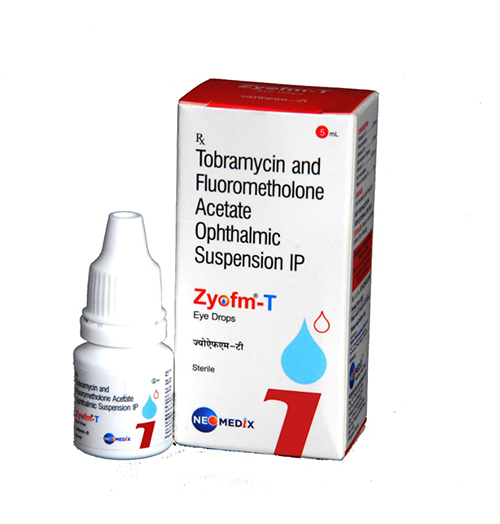
ZYOFM -T | Tobramycin and Fluotometholone Acetate Ophthalmic Suspension IP
For the use of a Registered Medical Pracitioner or a Hospital or a Laboratory
COMPOSITION:
Tobramycin IP………………………………………………..0.3% w/v
Fluorometholone acetate USP……………………………0.1% w/v
Benzalkonium Chloride solution IP……………………..0.02% v/v
(As Preservative)
Water for Injections IP……………………………………….q.s.
Clinical Pharmacology:
Corticoids suppress the inflammatory response to a variety of agents and they probably delay or slow healing. Since corticoids may inhibit the body’s defense mechanism against infection, a concomitant antimicrobial drug may be used when this inhibition is considered to be clinically significant. Clinical studies have demonstrated that Fluorometholone Acetate Suspension is a potent corticosteroid.
In clinical studies of documented steroid-responders, fluorometholone acetale demonstrated a significantly longer average time to produce a rise in intraocular pressure than dexamethasone phosphate; however, in a small percentage of individuals, a significant rise in intraocular pressure occurred within one week. The ultimate magnitude of the rise was equivalent for both drugs.
The antibiotic component in the combination (tobramycin) is included to provide action against susceptible organisms.
Bacterial susceptibility studies demonstrate that in some cases microorganisms resistant to gentamicin remain susceptible to tobramycin. Bacterial resistance to tobramycin may develop upon prolonged use.
No data are available on the extent of systemic absorption from 2yon-T Ophthalmic Suspension; however, it is known that some systemic absorption can occur with ocularly applied drugs.
When a decision to administer both a corticold and an antibiotic is made, the administration of such drugs in combination has the advantage of greater patient compliance and convenience, with the added assurance that the appropriate dosage of both is administered, plus assured compatibility of Ingredients when both types of drug are in the same formulation and, particularly. that the correct volume of drug is delivered and retained.
Indications and Usage:
Zyofm-T Ophthalmic Suspension is indicated for steroid responsive inflammatory ocular conditions for which a corticosteroid is indicated and where superficial bacterial ocular infection or a risk of bacterial ocular infection exists.
Ocular steroids are indicated in inflammalory conditions of the palpebral and bulbar conjunctiva, comes and anterior segment of the globe where the inherent risk of steroid use in certain infective conjunctivitides is accepted to obtain a diminution in edema and inflammation. They are also indicated in chronic anterior uveitis and corneal Injury from chemical, radiation or thermal burns, or penetration of foreign bodies.
The use of a combination drug with an anti-infective component is indicated where the risk of superficial ocular infection is high or where there is an expectation that potentially dangerous numbers of bacteria will be present in the eye. The anti-infective drug in this product, tobramycin, is active against the following common bacterial eye pathogens: Staphylococi, including S. aureus and S. epidermis (coagulase-positive and coagulase-negative), including penicillin-resistant strains.
Streptococci, including some of the Group A bata-herolytic species, some nonhamolytic species, and some Streptococcus pneumoniae.
Pseudomonas aeruginosa, Escherichia call, Kobsiella pneumoniae, Enterobacter aerogenas, Proteus mirabilis, Morganella morgani, most Proteus vulgaris strains, Haemophilus influenzae and H. aegyptius, Moraxella lacunata, and Acinetobactar calcoaceticus (Herellea vaginacola) and some Neisseria species.
Contraindications:
Epithelial herpes simplex keratitis (dendritic keratitis), vaccinia, varicella, and many other viral diseases of the cornea and conjunctiva, mycobacterial infection of the eye. Fungal diseases of ocular structures. Hypersensitivity to any component of the medication.
Warnings:
NOT FOR INJECTION INTO THE EYE. Sensitivity to topically applied aminoglycosides may occur in some patients. It a sensitivity reaction does occur, discontinue use.
Precautions:
General
The possibility of fungal infections of the cornea should be considered alter long-term steroid dosing. As with other antibiotic preparations, prolonged use may result in overgrowth of nonsusceptible organisms, including fungi. I superinfection occurs, appropriate therapy should be initiated. When multiple prescriptions are required, or whether clinical judgement dictates, the patient should be examined with the aid of magnification such as slit-lamp biomicroscopy and, where appropriate, fluorescein staining.
Carcinogenesis, mutagenesis, impairment of fertility
No studies have been conducted to evaluate the carcinogenic or mutagenic potential. No impairment of fertility was noted in studies of subcutaneous tobramycin in rats at doses 50 and 100mg/kg/day. No studies of impairment of fertility by fluorometholone acetate are available.
Pregnancy
Pregnancy category C. Animal studies have been conducted with Zyofm-T ophthalmic suspension. Fluorometholone has been shown to be embryocidal and teratogenic in rabbits when administered at low multiples of the human dose. Fluorometholone was applied ocularly to rabbits daily on days 6 to 18 of gestation, and dose related fetal loss and fetal abnormalities including deft palate, deformed rib cage, anomalous limbs and neural abnormalities such as encaphalocaia, craniorachischisis, and spina bifida were observed. Reproduction studies have been performed in rats an rabbits with tobramycin at parenteral doses upto 100 mg/kg/day with no evidence of harm to the fetus (2000X the maximum recommended human doses). There are no adequate and well controlled studies of Zyofm-T ophthalmic suspension in pregnant women. Zyofm-T ophthalmic suspension should be used during pregnancy only if the potential benefit justifies the potential risk to the fetus.
Nursing Mothers
Systemically administered corticostsrolds agpear in human milk and could suppress growth, interfere with endogenous corticosteroid production, or cause other untoward effects. It is not known whether topical administration of corticosteroids could result in sufficient systemic absorption to produce detectable quantities in human milk. Because many drugs are excreted in human milk, caution should be exercised when Zyon-T Ophthalmic Suspension is administered to a nursing woman.
Pediatric Use
Safety and effectiveness in pediatric patients below the age of 2 years have not been established.
Geriatic Use
No overall differences in safety or effectiveness have been observed between elderly and younger patients.
Adverse Reactions:
Adverse reactions have occurred with steroid/ant-infective combination drugs which can be attributed to the steroid component, the anti-infective component, or the combination. Exact incidence figures are not available.
Secondary Infection: The development of secondary infection has occurred ether use of combinations containing steroids and antimicrobials
Dosage and Administration:
As directed by the Physician
Storage Instructions:
KEEP IN A COOL PLACE
PROTECT FROM LIGHT.
KEEPOUT OF REACH OF CHILDREN
FOR EXTERNAL USE ONLY
SHAKE WELL BEFORE USE
Presentation:
Zyofm-T is a sterile ophthalmic suspension supplied in plastic opaque dropper bottle with a cap containing 5ml of the suspension
Use the suspension within one month after opening the container.


